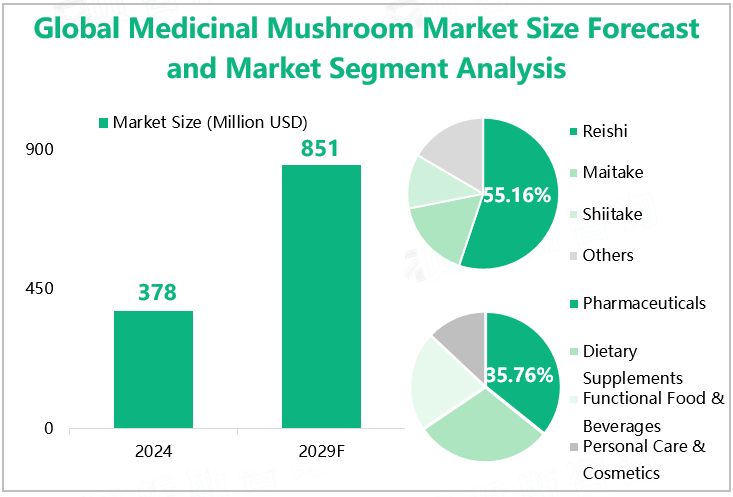Medicinal mushrooms refer to fungi that can produce health benefits, prevent, inhibit, or treat diseases in their mycelium, fruiting bodies, sclerotia, or spores. They not only contain rich nutrients such as protein, polysaccharides, vitamins, etc., but also contain various bioactive substances such as amino acids, glycosides, alkaloids, etc.
Overview of Market Development
Medicinal mushrooms have wide applications in both traditional Chinese medicine and modern medicine, and are important resources for researching and developing new drugs. In recent years, the global medicinal mushroom market has steadily grown. According to our research data, the global medicinal mushroom market size in 2024 is estimated to reach $378 million, an increase of 5.42% compared to 2023. This is mainly due to the increasing demand of consumers for healthy foods and functional supplements, as well as the widespread recognition of the unique antioxidant, antibacterial, and immune enhancing effects of medicinal mushrooms.
It is expected that the global medicinal mushroom market will continue to maintain a rapid growth trend in the coming years. With the rise of preventive medicine and alternative medicine, as well as the increasing preference of consumers for natural health products, the market demand for medicinal mushrooms will further expand. Meanwhile, the development of cutting-edge indoor mushroom cultivation techniques will also drive stable growth in market supply. It is expected that by 2029, the global medicinal mushroom market size will increase to $851 million. The CAGR for 2024-2029 is estimated to be 17.62%.
Segmented Market Analysis
From the perspective of product types, medicinal mushrooms can be classified into multiple types based on their medicinal parts and efficacy. Common ones include reishi, maitake, shiitake, cordyceps sinensis, and tuckahoe etc. They each have unique medicinal values and effects, such as anti-tumor, enhancing immunity, regulating blood lipids, etc. Research shows that the reishi sub category holds the largest market share, with an estimated 55.16% in 2024.
From the perspective of downstream application pattern, medicinal mushrooms are mainly used in pharmaceutical, dietary supplements, functional food and beverages, personal care and cosmetics. Among them, the pharmaceutical industry is the largest downstream application market, with an estimated application share of 35.76% in 2024.
Global Medicinal Mushroom Market Size Forecast and Market Segment Analysis

Source: www.globalmarketmonitor.com
Market Analysis of Major Regions/Countries
From a regional perspective, the global medicinal mushroom market is mainly concentrated in North America, Europe, and the Asia Pacific region. Among them, the Asia Pacific region is the largest production area, accounting for over 60% of the global production of medicinal mushrooms. From a national perspective, China is the largest producer. Data shows that the production of medicinal mushrooms in China is expected to reach 2776.1 tons in 2024, accounting for an estimated 42.77% of the total production.
Global Medicinal Mushroom Production and Proportion by Region/Country Forecast in 2024
|
Regions/Countries
|
Production (Tons)
|
Proportion
|
|
North America
|
1045.3
|
16.10%
|
|
Europe
|
814.2
|
12.54%
|
|
China
|
2776.1
|
42.77%
|
|
Japan
|
846.0
|
13.03%
|
|
India
|
332.7
|
5.13%
|
|
South America
|
318.0
|
4.90%
|
|
Middle East & Africa
|
123.2
|
1.90%
|
Source: www.globalmarketmonitor.com
For more industry information, please refer to our latest released "2023 Global Medicinal Mushroom Market Analysis Report, Key Competitors, Market Effect Factors, Growth, And Forecast".
